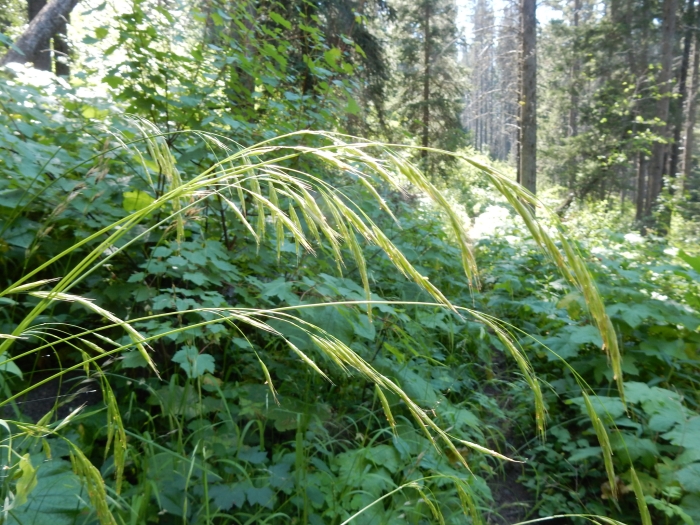Columbia Brome
(Bromus vulgaris)
Columbia Brome (Bromus vulgaris)
/
/

Matt Lavin
CC BY 4.0
Image By:
Matt Lavin
Recorded By:
Copyright:
CC BY 4.0
Copyright Notice:
Photo by: Matt Lavin | License Type: CC BY 4.0 | License URL: http://creativecommons.org/licenses/by/4.0/ | Rights Holder: Matt Lavin | Publisher: iNaturalist | Date Created: 2016-08-01T15:22:13-07:00 |

























Estimated Native Range
Summary
Bromus vulgaris, commonly known as Columbia brome, is a perennial grass that is native to the temperate coniferous forests of western North America, specifically from British Columbia to California and east to Wyoming. It typically grows up to 4 feet tall and is characterized by its open arrays of spikelets, with the lower ones tending to droop. The spikelets bear flattened fruits, each with an awn that can be up to a centimeter long. Flowering occurs in late spring to early summer, and the plant is not particularly showy but has a subtle beauty in its natural setting.
Columbia brome is appreciated for its adaptability to various forest habitats and is considered good forage for livestock and wildlife. It is often used in restoration projects and erosion control due to its ability to establish quickly and form dense stands. This grass prefers moist, well-drained soils and can tolerate partial shade, although it thrives in full sun. While it is not commonly used in ornamental horticulture, it can be a useful addition to naturalized areas or meadow gardens. Columbia brome is generally low-maintenance but can be susceptible to rust diseases in some conditions.CC BY-SA 4.0
Columbia brome is appreciated for its adaptability to various forest habitats and is considered good forage for livestock and wildlife. It is often used in restoration projects and erosion control due to its ability to establish quickly and form dense stands. This grass prefers moist, well-drained soils and can tolerate partial shade, although it thrives in full sun. While it is not commonly used in ornamental horticulture, it can be a useful addition to naturalized areas or meadow gardens. Columbia brome is generally low-maintenance but can be susceptible to rust diseases in some conditions.CC BY-SA 4.0
Plant Description
- Plant Type: Grass
- Height: 2-3.9 feet
- Width: 1-2 feet
- Growth Rate: Moderate
- Flower Color: N/A
- Flowering Season: Spring, Summer
- Leaf Retention: Deciduous
Growth Requirements
- Sun: Part Shade, Full Shade
- Water: Medium, High
- Drainage: Fast, Medium
Common Uses
Bird Garden, Erosion Control, Low Maintenance
Natural Habitat
Temperate coniferous forests of western North America from British Columbia to California and east to Wyoming
Other Names
Common Names: Columbian Brome, Common Bromegrass, Common Brome, Narrow-Flowered Brome
Scientific Names: , Bromus vulgaris, Bromopsis vulgaris, Bromus ciliatus var. glaberrimus, Bromus ciliatus var. ligulatus, Bromus ciliatus var. pauciflorus, Bromus ciliatus var. pauciflorus, Bromus ciliatus var. pauciflorus, Bromus debilis, Bromus eximius
GBIF Accepted Name: